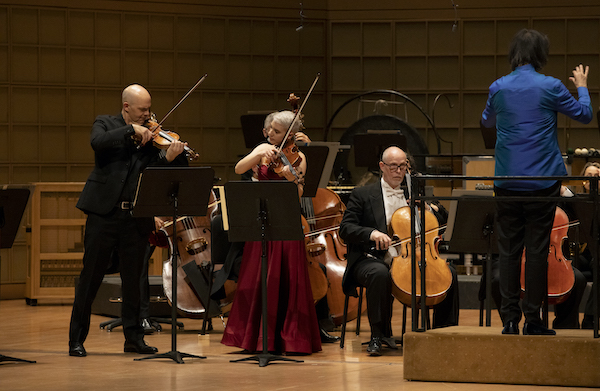Kavakos, DSO go from light to dark with Mozart, Prokofiev

The Dallas Symphony Orchestra’s concert Thursday night was a stout presentation of the organization’s breadth of talent and skill. Featuring two DSO soloists under the direction of guest conductor Leonidas Kavakos, a diptych of Mozart and Prokofiev brought an evening of fine playing to the Meyerson Symphony Center.
The genesis of Mozart’s Sinfonia Concertante for Violin, Viola, and Orchestra is shrouded in mystery. In fact, the first published edition of the work only appeared ten years after his death and is based on surviving fragments of Mozart’s original manuscript. In all likelihood, the piece was composed in the latter part of 1779 at the tail end of what he called his “Salzburg slavery”—the two-year period that covered his last stint of service to the Archbishop of Salzburg.
The popular sinfonia concertante form married compositional elements of the symphony and the concerto, often featuring two or more soloists. Here, Mozart exhibits an extensiveness of orchestral language and color on par with any of his greatest symphonies, even in the condensed setting called for by the score’s instrumentation—two oboes, 2 horns, and strings.
Kavakos, himself a celebrated violin virtuoso, employed a sprightly, delicate touch in his gesturing, which translated to light, buoyant phrasing from the ensemble—which he arranged in the traditional, pre-1930s formation of first and second violins split on either sides of the stage.
The opening movement, replete with endearing themes and echoes of Mozart’s sojourn in Salzburg, was given an attentive orchestral finesse before a dynamic swells introduced the two soloists.
Entering gracefully on a jointly sustained high note, DSO concertmaster Alexander Kerr and principal violist Meredith Kufchak spun a sonorous thread of banter—with one another and with the orchestra—executing with deft precision and a united gleaming, silvery lilt. (Sticking with modern convention, Kufchak forgoes the original scordatura, which calls for the solo viola to be tuned a half-step higher from the others so as to stand out from the orchestral sections.)
The tragic mood of the slow movement was effectively captured by the soloists. Kavakos’s gracious conducting style left ample room for phrasing—in both soloists and orchestral passages—to breathe, distending and suspending naturally. The work’s closing Presto finds Mozart at his most joyous, emulated in the tight coordination of soloists and ensemble before a spry, lovely finish.
The second half of the program featured Sergei Prokofiev’s provocative Sixth Symphony, unconventionally set in three movements.
Hailing from the era of postwar Stalinism in 1947, Prokofiev’s Sixth represents a much darker contrast against its more triumphant and highly acclaimed predecessor. The composer eschews much of the expectant demands of Socialist Realism at the time, leading to his denouncement by the notorious Congress of Composers. He was labeled a “decadent formalist” by his Stalin-aligned contemporaries and would find himself and the majority of his work blacklisted from public performance until his death some six years later.
The piece opened with harsh, dark strings—the DSO effectively evoking imagery of something colossal and lurking. Here, with the stage filled out in full orchestral complement, the brass was at times bracing, which was at times an effective fit for the mood and narrative of the work.
Kavakos managed to pull convincing transitions from this dark and imposing texture to sly parodic passages from the orchestra, oscillating between gentle, lyric gesturing to stark punctuated downbeats.
The second movement opened with hysterical woodwinds set against dusky strings, vibrating with angst and tension. Later in the movement, bold percussion ornaments were almost cheeky. The finale, with its Peter and the Wolf-esque passage for solo clarinet, was navigated smartly by the grand ensemble—the energetic vivace bolting cheerfully to a vibrant close.
The program will be repeated 7:30 p.m. Saturday and 3 p.m. Sunday. dallassymphony.org


